
current / archive / issues / faq / RSS feed / twitter /
Blog Archive: March 2018
From The Ashes Of DefeatThere are major appearances by Doctor Doom and there are minor appearances, there are lead roles and their are cameos, and sometimes he's in a comic so very very slightly that none - NONE - of the comics databases I used recognise that it's him.
This is one such occasion, for in this comic Doctor Doom only appears once, right at the very end of the story, in silhouette in a single caption.
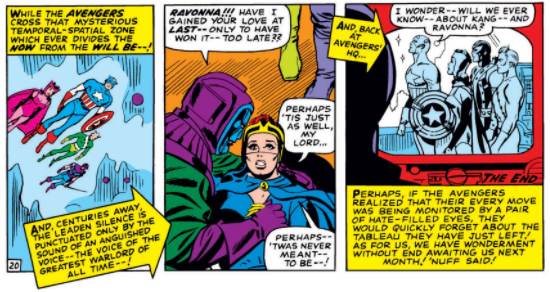 We don't find out that it's him until the following month, but it IS him so I think this has to be included. We'll find out what he's up to soon!
We don't find out that it's him until the following month, but it IS him so I think this has to be included. We'll find out what he's up to soon!
posted 30/3/2018 by MJ Hibbett
(click here for permanent link)
(0) comments
Bedlam At The Baxter Building
The cover of this story promises "the world's most colossal collection of costumed characters crazily cavorting and capering in continual combat" and, in all honesty, that's pretty much what the contents provide.
The subject of this story is supposedly the wedding of Reed Richards and Sue Storm, and it does feel like a wedding. You're forever bumping into people you've not seen for a while, some of whom you like and some you don't, and all sorts of individuals from different parts of your life get thrown together. Also there's a lot of fighting.
More than that though, this is the culmination of the entire Marvel Universe so far. Almost every character who's appeared already gets a cameo, and those who don't get notes to explain why they're not there. It is, to be frank, one heck of a ride!
It all kicks with Doom reading about Reed and Sue's wedding, still fuming about his recent humiliation. He's so furious that he rips up his newspaper.
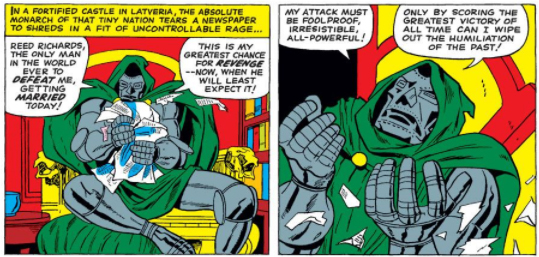 Once he's had his tantrum Doom decides to use the situation to his advantage and ruin his enemies' big day. He reasons that, as the Fantastic Four are "the greatest fighting team the world has ever known" he needs an even greater team of foes to defeat them, and decides to use his handy High Frequency Emotion Charger to impel super-powered types from all over the world to converge on the Baxter Building, where the police who so recently had been evacuating crowds are now holding them back from celebrations.
Once he's had his tantrum Doom decides to use the situation to his advantage and ruin his enemies' big day. He reasons that, as the Fantastic Four are "the greatest fighting team the world has ever known" he needs an even greater team of foes to defeat them, and decides to use his handy High Frequency Emotion Charger to impel super-powered types from all over the world to converge on the Baxter Building, where the police who so recently had been evacuating crowds are now holding them back from celebrations.
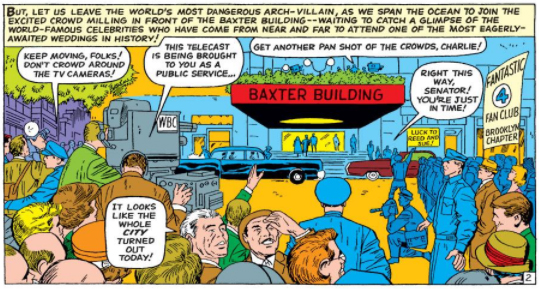 The presence of the cops outside is a callback to Doom's last appearance in the similarly titled Battle Of The Baxter Building, where the FF needed the help of Daredevil to defeat him. The Fantastic Four won by enlisting help that time, and both sides will do the same here.
The presence of the cops outside is a callback to Doom's last appearance in the similarly titled Battle Of The Baxter Building, where the FF needed the help of Daredevil to defeat him. The Fantastic Four won by enlisting help that time, and both sides will do the same here.
After the quick prologue in Latveria we're thrown into a parade of supporting characters from all over the Marvel Universe and beyond. Tony Stark turns up first, but then in the crowd we see Patsy Walker and Hedy Wolfe, stars of Timely Comics romance comics which were pulished before and then alongside early Marvel stories. This is their first "official" appearance in the Marvel Universe, and is a statement of intent from Stan Lee - he's prepared to bring absolutely everything he writes into the Marvel storyworld!
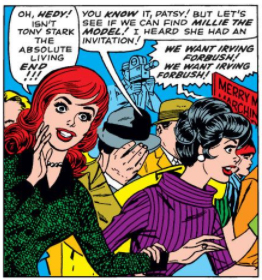 More and more characters appear from this point onward, including FF villains such as The Puppet Master, Mole Man and The Red Ghost, plus heroes such as The X-Men, Nick Fury and Doctor Strange. This gives the reader the opportunity to see new pairings of heroes and villians fighting each other, and generates a feeling of everything coming together in an exciting, coherent, very busy shared storyworld.
More and more characters appear from this point onward, including FF villains such as The Puppet Master, Mole Man and The Red Ghost, plus heroes such as The X-Men, Nick Fury and Doctor Strange. This gives the reader the opportunity to see new pairings of heroes and villians fighting each other, and generates a feeling of everything coming together in an exciting, coherent, very busy shared storyworld.
On page 9 of the story there's a cut back to Latveria, where we see Doctor Doom monitoring the situation - using a television, of course.
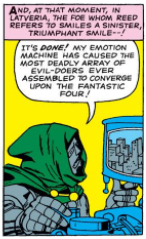 We haven't seen much of him since the first couple of pages and, surprisingly, this is the last we'll see of him in the whole story. After this more and more villians turn up to fight more and more heroes, but that's it for Doom.
We haven't seen much of him since the first couple of pages and, surprisingly, this is the last we'll see of him in the whole story. After this more and more villians turn up to fight more and more heroes, but that's it for Doom.
There's still an awful lot to enjoy about the rest of the story, as Lee and Kirby revel in the richness of this fictional world they've created. My personal favourite aspect is the story of The Hydra Bomb Lorry, which Daredevil spots heading towards the Baxter Building.
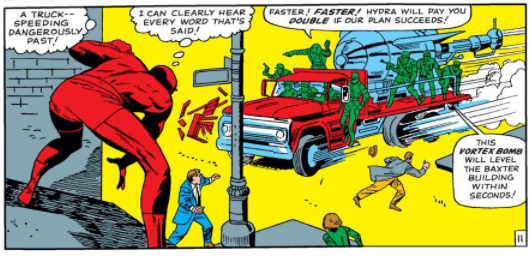 It's a beautifully daft image of the Keystone Cops-like villains driving a super high tech bomb on the back of a pick-up truck, which Daredevil easily manages to steal from them. It's one short sequence in a succession of similar ones in which supervillains literally turn up round every corner.
It's a beautifully daft image of the Keystone Cops-like villains driving a super high tech bomb on the back of a pick-up truck, which Daredevil easily manages to steal from them. It's one short sequence in a succession of similar ones in which supervillains literally turn up round every corner.
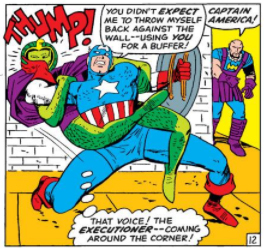 We catch up with Daredevil and The Bomb Bus a few pages later as it drives past a fight between The Black Knight and Angel of The X-Men, which escalates until pretty much everybody is fighting everybody else.
We catch up with Daredevil and The Bomb Bus a few pages later as it drives past a fight between The Black Knight and Angel of The X-Men, which escalates until pretty much everybody is fighting everybody else.
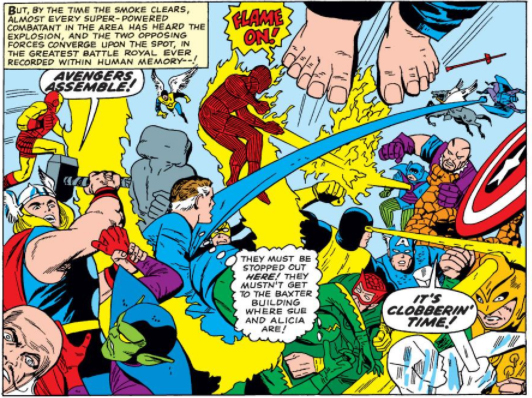 It's a joyous celebration of the world that Marvel have created, which continues to escalate even after this, as a whole army of Atlantean soldiers appear in the harbour.
It's a joyous celebration of the world that Marvel have created, which continues to escalate even after this, as a whole army of Atlantean soldiers appear in the harbour.
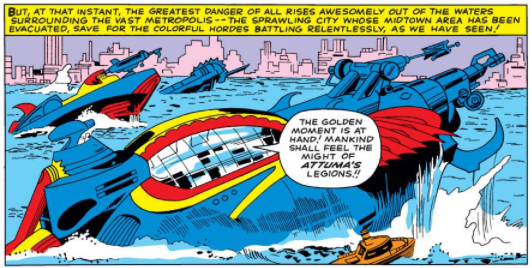 Even here there's room for more interconnectivity. A text box explains that, though Attuma has turned up, it was the Sub-Mariner that Doom was hoping for, and if the reader wishes to find out why Namor couldn't make it... then they need to go and pic up "Tales To Astonish" #72!
Even here there's room for more interconnectivity. A text box explains that, though Attuma has turned up, it was the Sub-Mariner that Doom was hoping for, and if the reader wishes to find out why Namor couldn't make it... then they need to go and pic up "Tales To Astonish" #72!
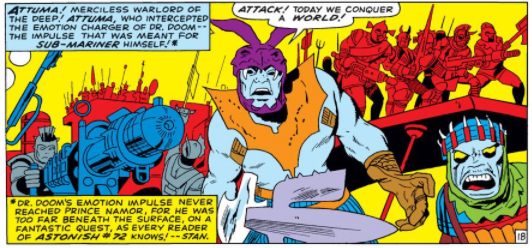 Before Attuma's armies can attack New York, Daredevil and the Bomb Bus appear again, with Daredevil leaping off just in time before the lorry careers into the harbour and explodes... sending the Atlantean army back into the depths from which they came before anybody even realised they were there!
Before Attuma's armies can attack New York, Daredevil and the Bomb Bus appear again, with Daredevil leaping off just in time before the lorry careers into the harbour and explodes... sending the Atlantean army back into the depths from which they came before anybody even realised they were there!
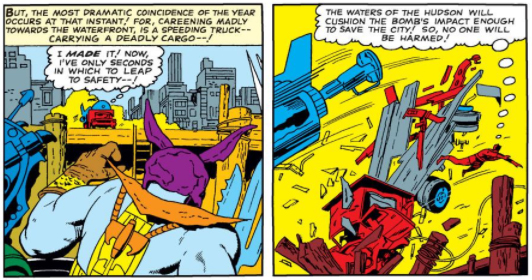 In order to wrap everything up The Watcher appears and does his usual immaculate job of not interfering by totally interfering, taking Reed to the moon to collect a sub-atronic time displacer which not only sends all the baddies back to where they came from but also makes them forget all about it - including Doctor Doom himself, apparently.
In order to wrap everything up The Watcher appears and does his usual immaculate job of not interfering by totally interfering, taking Reed to the moon to collect a sub-atronic time displacer which not only sends all the baddies back to where they came from but also makes them forget all about it - including Doctor Doom himself, apparently.
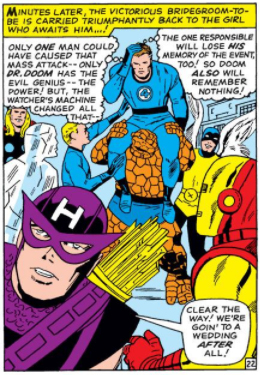 This is a bit of a throwback to the early days of the Fantastic Four, when Stan and Jack would need to invent some sort of previously unmentioned device to get the story to a close, but it's a minor misstep in what has otherwise been a thrilling story, which just has room to fit the actual wedding in on the last page... and another slice of Jack Kirby's romance comics illustration style.
This is a bit of a throwback to the early days of the Fantastic Four, when Stan and Jack would need to invent some sort of previously unmentioned device to get the story to a close, but it's a minor misstep in what has otherwise been a thrilling story, which just has room to fit the actual wedding in on the last page... and another slice of Jack Kirby's romance comics illustration style.
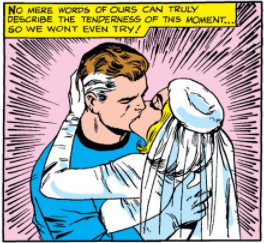 I must admit I was a little bit disappointed with the group shot of the wedding, as I expected it to be a big splash page, but then realised that I was thinking of the (wonderful) version of this scene that appears in Kurt Busiek and Alex Ross's "Marvels" series.
I must admit I was a little bit disappointed with the group shot of the wedding, as I expected it to be a big splash page, but then realised that I was thinking of the (wonderful) version of this scene that appears in Kurt Busiek and Alex Ross's "Marvels" series.
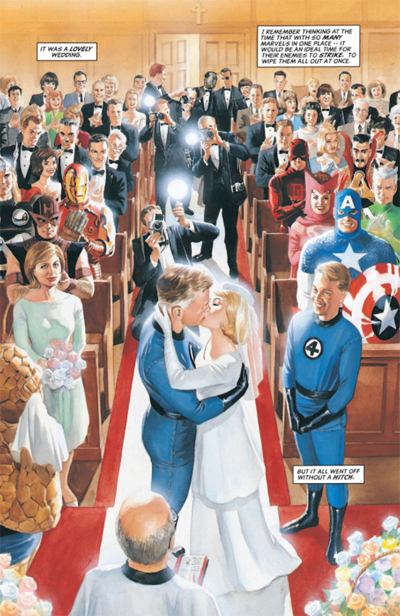 I do like the joke here about the whole thing going off without a hitch!
I do like the joke here about the whole thing going off without a hitch!
All that remains is one final gag about Stan Lee and Jack Kirby not being allowed entry, and that's the story done. It's not a big story for Doctor Doom, and he'll apparently have forgotten all about it by the next time we see him, but it's a HUGE story for the Marvel Universe as whole, bringing together almost every character seen so far in a celebration of what you can do with a shared storyworld.
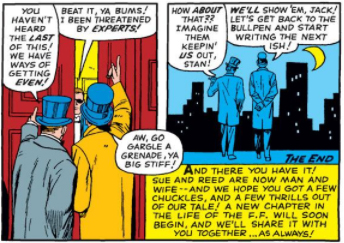
posted 28/3/2018 by MJ Hibbett
(click here for permanent link)
(0) comments
Lo! There Shall Be An Ending!
A very brief appearance by Doctor Doom in this one - it's a cameo, but for the first time it's not someone else remembering him, or a statuette, but Doom himself, demonstrating that the Marvel Universe has definitely become a single ongoing story rather than a series of one-offs.
This issue is the final part of a three-issue storyline about Ben Grimm being taken over by The Wizard and The Frightful Four, carrying on directly from the storyline covered last time, where he was forced to become The Thing again to defeat Doctor Doom. Distraught about what has happened he wanders off and is captured by The Wizard who uses his ID machine to activate Ben's darkest thoughts.
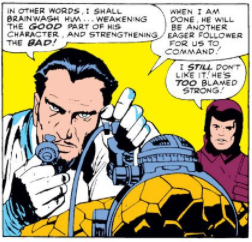 The Wizard says that this is "brainwashing" him, but surely that's when you put new ideas into someone's head, rather than emphasising existing ones? Anyway, what happens is that Ben realises how much he hates Reed Richards and how much he likes smoking cigars. He smokes a LOT of cigars in this story.
The Wizard says that this is "brainwashing" him, but surely that's when you put new ideas into someone's head, rather than emphasising existing ones? Anyway, what happens is that Ben realises how much he hates Reed Richards and how much he likes smoking cigars. He smokes a LOT of cigars in this story.
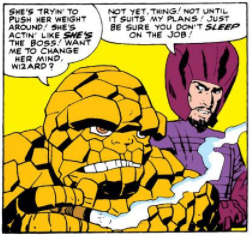 The Frightful Four (who surely should be Five now?) bicker amongst each other, Johnny Storm goes undercover (badly), Reed Richards gets trapped in a jar, and Sue faints after rescuing him. It all ends up with Reed trying to de-brainwash The Thing, in an operation which could easily kill him.
The Frightful Four (who surely should be Five now?) bicker amongst each other, Johnny Storm goes undercover (badly), Reed Richards gets trapped in a jar, and Sue faints after rescuing him. It all ends up with Reed trying to de-brainwash The Thing, in an operation which could easily kill him.
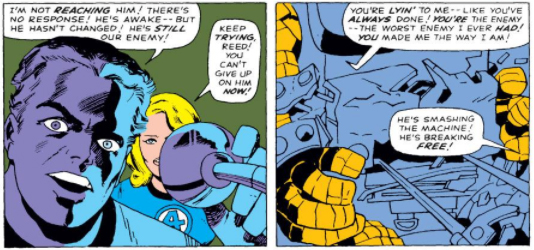 The lighting in this image shows Reed in proper Mad Scientist mode, because that's basically what he is - rather than deal with the very understandable feelings of his friend, who was been turned into a monster by ill-thought out Mad Science, he is using MORE Mad Science to try and wipe it from his brain, while risking death if he should make another error. It all works out in the end, but this is one of those occasions when one sympathises with those who think Mr Fantastic is just the tiniest bit arrogant.
The lighting in this image shows Reed in proper Mad Scientist mode, because that's basically what he is - rather than deal with the very understandable feelings of his friend, who was been turned into a monster by ill-thought out Mad Science, he is using MORE Mad Science to try and wipe it from his brain, while risking death if he should make another error. It all works out in the end, but this is one of those occasions when one sympathises with those who think Mr Fantastic is just the tiniest bit arrogant.
Which brings us nicely to Victor Von Doom, who we see halfway through the issue recovering in the Latverian embassy from the wounds inflicted last time we saw him.
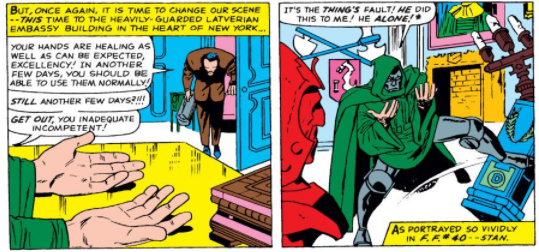 I'm going to stop going on about Latveria soon, but it's very noticeable that Latveria is now always mentioned in pretty much the first sentence of his every appearance. It was introduced less than a year ago, but now it's a core part of Doom's character.
I'm going to stop going on about Latveria soon, but it's very noticeable that Latveria is now always mentioned in pretty much the first sentence of his every appearance. It was introduced less than a year ago, but now it's a core part of Doom's character.
We discover that Doom is still in pain, and must wait a few days before he can use his Emotion Charger to take revenge. He then looks out of the window to see that something's going on at The Baxter Building... and we're back into the main story again.
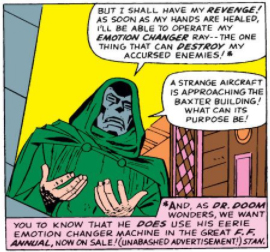 This three panel sequence has absolutely nothing to do with the rest of this issue, and thus it shows how important the ongoing Marvel Universe has become, and how the idea of a "done in one" story has been completely rejected. It also shows the economic side of the development of continuity - usually the footnotes tell readers what issue they need to go back to to check something, here they're told that they can find out what Doom's Emotion Charger does in Fantastic Four Annual #3, out now!
This three panel sequence has absolutely nothing to do with the rest of this issue, and thus it shows how important the ongoing Marvel Universe has become, and how the idea of a "done in one" story has been completely rejected. It also shows the economic side of the development of continuity - usually the footnotes tell readers what issue they need to go back to to check something, here they're told that they can find out what Doom's Emotion Charger does in Fantastic Four Annual #3, out now!
This, of course, is a heinous mis-use of ontological security to promote purely mercenary motives, and is something I would never condone. "But does it work?" you may ask - you can find out yourself, in the NEXT Marvel Age Doom Blog, available later this week!
posted 26/3/2018 by MJ Hibbett
(click here for permanent link)
(0) comments
The Battle Of The Baxter Building
This issue already has a lot to live up to, following on from the thrills of A Blind Man Shall Lead Them, and it ramps up the expectation even more with a splash page that is a) fantastically designed and b) erring very slightly on the side of immodesty.
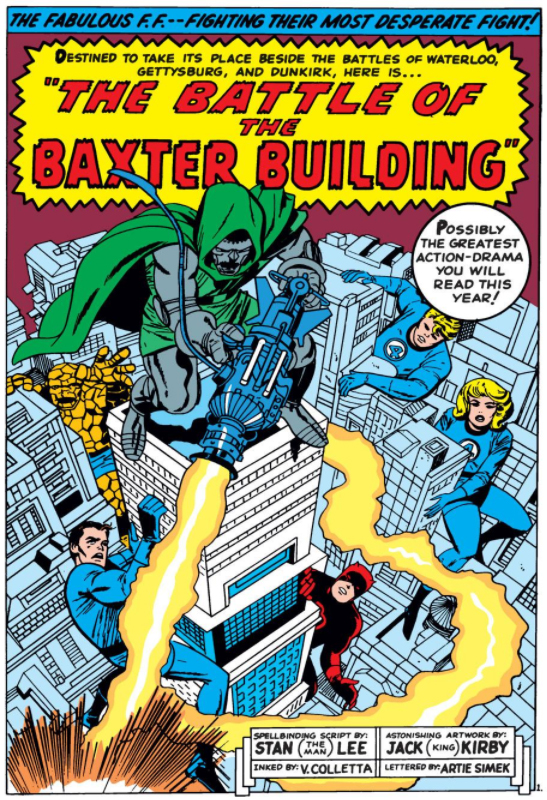 Let's take a moment to gaze in awe at this page. It's Lee and Kirby at the peak of their game, with utterly ludicrous descriptions that you can't help but be swept along with, coupled with incredibly dynamic character art full ofpersonality and bizarre technology. Surely the story itself cannot compete with a beginning like this?
Let's take a moment to gaze in awe at this page. It's Lee and Kirby at the peak of their game, with utterly ludicrous descriptions that you can't help but be swept along with, coupled with incredibly dynamic character art full ofpersonality and bizarre technology. Surely the story itself cannot compete with a beginning like this?
I said last time that there hadn't been quite so much use of televisions as plot devices lately, but straight away we get one here as Doom uses Reed Richard's remote control TV eye to track down the Fantastic Four.
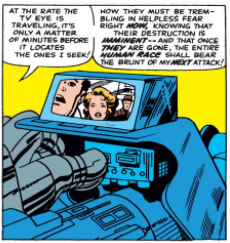 Doom is still referring to his own intelligence as "equal" to Reed Richards, rather than greater as he will in future, but his link to Latveria is now set in stone. He even wonders if he's remained there too long, "unconcerned about the rest of mankind".
Doom is still referring to his own intelligence as "equal" to Reed Richards, rather than greater as he will in future, but his link to Latveria is now set in stone. He even wonders if he's remained there too long, "unconcerned about the rest of mankind".
Daredevil continues to protect the powerless Fantastic Four from Doom's attacks, allowing Reed, Johnny and Sue to regroup inside the Baxter Building, which has been sealed off by police to allow them to fight without hurting bystanders. Daredevil makes his way to the laboratory and commences a fight with Doom which gives the FF, soon joined by Ben Grimm, to make their way upstairs. Jack Kirby makes this whole process thrilling, constantly cutting back between the fight and the perilous journey upstairs, as Reed attempts to protect his colleagues from his own inventions while Daredevil tries to keep Doom busy.
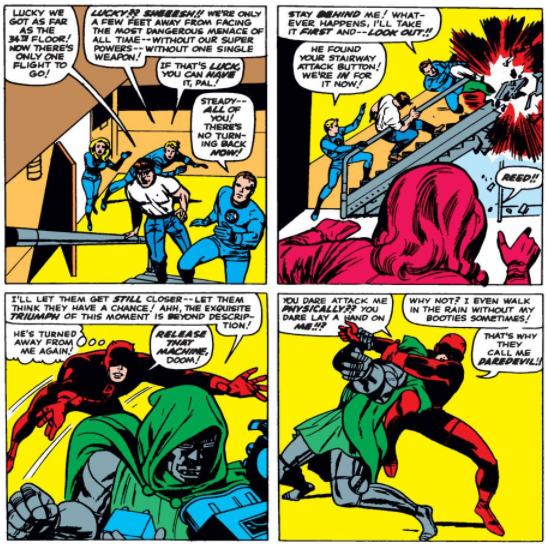 There's a noticeable lack of text descriptions in this sequence - previously you might expect boxes saying "Meanwhile in Doom's lab" to tell the reader exactly what's going on, but as the pace picks up Stan Lee, for once, drops the verbiage and allows the images to sell the story. This speeds things up considerably and, again, demonstrates the pair of creators acting as a coherent team.
There's a noticeable lack of text descriptions in this sequence - previously you might expect boxes saying "Meanwhile in Doom's lab" to tell the reader exactly what's going on, but as the pace picks up Stan Lee, for once, drops the verbiage and allows the images to sell the story. This speeds things up considerably and, again, demonstrates the pair of creators acting as a coherent team.
That's not to say there's no text descriptions - Lee can't seem to hold back from explaining things for long - which does lead to a rather odd moment when Doom does not recognise the de-powered Ben Grimm.
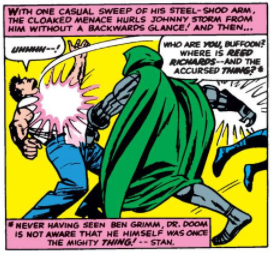 There's a footnote to underline that Doom does not recognise Ben in human form, but we already know that Doom was at college with Reed Richards, and that Reed and Ben were friends at the time, so surely that wouldn't be the case? It makes me wonder whether Lee realised that this didn't make sense at the dialoguing stage, and sought to paper it over with a footnote.
There's a footnote to underline that Doom does not recognise Ben in human form, but we already know that Doom was at college with Reed Richards, and that Reed and Ben were friends at the time, so surely that wouldn't be the case? It makes me wonder whether Lee realised that this didn't make sense at the dialoguing stage, and sought to paper it over with a footnote.
While all that goes on Reed Richards digs out another one of his devices, a power stimulator ray gun that can restore their powers. Here we see the continuity of the series being used to great effect - this is not just some random device that the creators have dreamt up to finish the story (as they've been known to do before) but an item already established a few issues ago in, according to the handy citation given, Fantastic Four #37
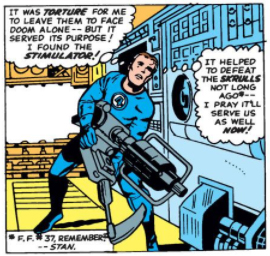 The references to previous adventures are coming thick and fast, as with the previous issue, not just reinforcing the idea of a coherent universe but using it to enrich stories, and get them told quicker too!
The references to previous adventures are coming thick and fast, as with the previous issue, not just reinforcing the idea of a coherent universe but using it to enrich stories, and get them told quicker too!
Reed, Johnny and Sue get their powers back, and with Daredevil's help manage to fight Doom to a standstill. He escapes up to the roof, leaving Ben Grimm to face a terrible choice - in order to defeat Doom, he must reinstate his powers, and in the process lose his humanity!
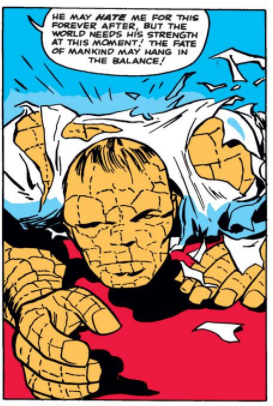 This is a timely reminder of the fact that The Fantastic Four, and indeed all Marvel characters, are not the same as the old heroes that came before. They don't necessarily want to be superheroes, and they always have to face a price for their abilities.
This is a timely reminder of the fact that The Fantastic Four, and indeed all Marvel characters, are not the same as the old heroes that came before. They don't necessarily want to be superheroes, and they always have to face a price for their abilities.
Doom, meanwhile, has gone to set up his final piece of villainy - a time bomb which will "destroy everything in sight". It's not entirely clear what he hopes to achieve with this, except for ensuring that "the name of Doctor Doom shall forever live in infamy." It's a harking back to his roots as a conventional supervillain who just wants to destroy things, rather than the complex, intelligently motivated, character that he's becoming.
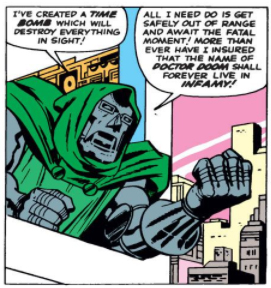 There then follows a five page sequence of Doctor Doom and The Thing fighting each other, in which Victor's technological skills and intelligence are pitted against Ben's brute strength and determination. The fight swings back and forth between them, with neither willing to give way, and Doom especially unwilling to countenance the idea that brawn could ever beat brains.
There then follows a five page sequence of Doctor Doom and The Thing fighting each other, in which Victor's technological skills and intelligence are pitted against Ben's brute strength and determination. The fight swings back and forth between them, with neither willing to give way, and Doom especially unwilling to countenance the idea that brawn could ever beat brains.
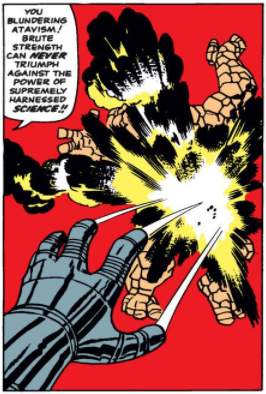 I had to look up the word "atavism" there, to find that Doom, or rather Stan Lee, is using it correctly. As I always say to anybody who'll listen (and plenty who stopped listening long ago), I learnt most of what I know through reading Marvel Comics, especially in terms of vocabulary - they're good for you!
I had to look up the word "atavism" there, to find that Doom, or rather Stan Lee, is using it correctly. As I always say to anybody who'll listen (and plenty who stopped listening long ago), I learnt most of what I know through reading Marvel Comics, especially in terms of vocabulary - they're good for you!
Eventually Ben's determination wears Doom down, in an example of recurring theme in superhero comics where determination is the main virtue, with overwhelming odds only overcomable by sheer force of will. The most famouse instance of this comes in Amazing Spider-Man #33, published six months later in 1966, in the endlessly referenced scene where Spider-Man talks himself into lifting impossibly heavy machinery that he's otherwise trapped beneath.
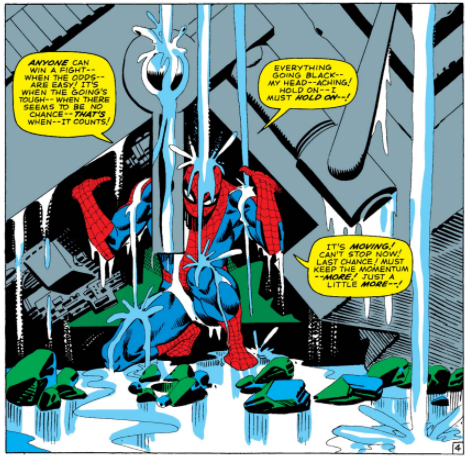 Ben's selfless determination wins the day here too, with Reed Richards having to step in to stop him going all the way and killing Doom.
Ben's selfless determination wins the day here too, with Reed Richards having to step in to stop him going all the way and killing Doom.
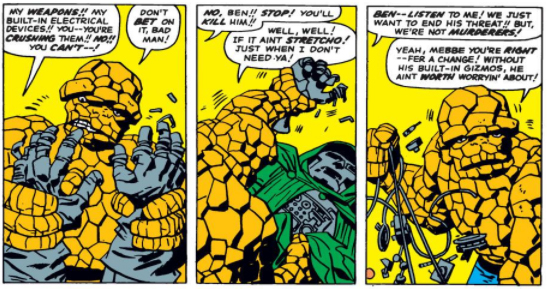 This is pretty heavy stuff - one can't imagine Superman having to be talked down from murdering somebody (at least not in comics anyway), and Ben's reasons for stopping are not exactly in the classic hero mode either, saying he's only stopping because "without his built-in gizmos he ain't worth worryin' about!" This isn't quite true - it's been established since his first appearance that Doctor Doom is a master of both magic and science, although the magical aspect seems to have faded away somewhat in this story. We shall have to keep an eye out for its return in future!
This is pretty heavy stuff - one can't imagine Superman having to be talked down from murdering somebody (at least not in comics anyway), and Ben's reasons for stopping are not exactly in the classic hero mode either, saying he's only stopping because "without his built-in gizmos he ain't worth worryin' about!" This isn't quite true - it's been established since his first appearance that Doctor Doom is a master of both magic and science, although the magical aspect seems to have faded away somewhat in this story. We shall have to keep an eye out for its return in future!
We're on to the final page of the story now, with all loose ends needing to be wrapped up at lightning speed. Where previous stories have felt like the ending's been tacked on at the last minute, here it's the culmination of plot lines from this story and the universe as a whole.
Doom's defeat is not the complete victory we might have hoped for. As he crawls away Reed reminds us that he cannot be taken into custody because, as previously established, he has diplomatic immunity, but that the crushing of his ego should be enough to ensure their safety for now.
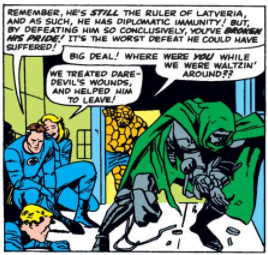 Doom has a long history of escaping at the end of these stories, but where previously (and repeatedly) he would fling himself out of a window or into the infinity of space, this time he is able to limp away, utterly defeated. Reed suggests that he may never recover from being beaten so soundly, but I think that those of us who have been watching Doom's development will suspect that it will only increase his resentment, and determination to try again.
Doom has a long history of escaping at the end of these stories, but where previously (and repeatedly) he would fling himself out of a window or into the infinity of space, this time he is able to limp away, utterly defeated. Reed suggests that he may never recover from being beaten so soundly, but I think that those of us who have been watching Doom's development will suspect that it will only increase his resentment, and determination to try again.
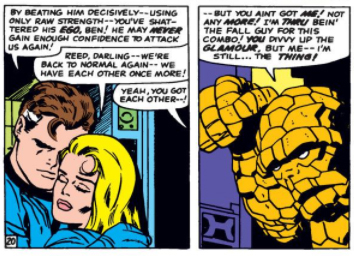 There's still more story to come though as, in a panel that proudly displays Kirby's long history in Romance Comics, Reed and Sue rather tactlessly declare their happiness that things are back to normal, only for Ben to point out that his situation is exactly the opposite. On the final panel he tenders his resignation from the team (not for the first time, and definitely not for the last), reminding us again that this is not your conventional superhero story.
There's still more story to come though as, in a panel that proudly displays Kirby's long history in Romance Comics, Reed and Sue rather tactlessly declare their happiness that things are back to normal, only for Ben to point out that his situation is exactly the opposite. On the final panel he tenders his resignation from the team (not for the first time, and definitely not for the last), reminding us again that this is not your conventional superhero story.
Massive fights, overwhelming odds, revolutionary storytelling techniques and a determination to change the way these sort of stories are told, all tied up with a creative team at the height of their powers - at the start of this I accused Lee and Kirby of immodesty when they said that this was "possibly the greatest action drama you will read this year", but now I'm wondering if they might have been right?
posted 23/3/2018 by MJ Hibbett
(click here for permanent link)
(0) comments
A Blind Man Shall Lead Them
When scholars and great thinkers gather to talk of the Lee & Kirby run on Fantastic Four, it is generally agreed that they really hit their stride somewhere around "The Galactus Trilogy" of issues 48-50. However, here at issue #39, they seeming to already be getting in the swing of it with a thrill-ride of fantastic storytelling which rockets along in a surprisingly modern-feeling fashion.
The issue kicks off with the Fantastic Four being picked up by a US Navy Submarine, having barely survived an atomic blast. The sailors are surprised to find that the superheroes are distinctly depressed because, as we soon learn, the atomic blast has deprived them of their powers!
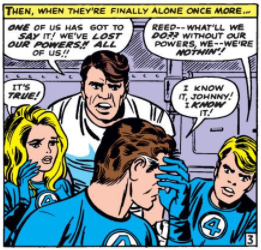 Once this revelation is out of the way we skip forward to Reed Richard's lab some time later (rendered with a fabulous Kirby Photo Montage) where he's developing artificial ways to replicate their powers. The results are not much cop, with a re-humanised (NB this is a genuine word, don't worry about looking it up) Ben Grimm being unable to control a special Thing Robot, and the others not having much luck either. There's some highly enjoyable character work here, with Reed Richards losing patience with the efforts of the others. They're all understandably worried though - what would happen if their enemies were to find out they'd lost their powers?
Once this revelation is out of the way we skip forward to Reed Richard's lab some time later (rendered with a fabulous Kirby Photo Montage) where he's developing artificial ways to replicate their powers. The results are not much cop, with a re-humanised (NB this is a genuine word, don't worry about looking it up) Ben Grimm being unable to control a special Thing Robot, and the others not having much luck either. There's some highly enjoyable character work here, with Reed Richards losing patience with the efforts of the others. They're all understandably worried though - what would happen if their enemies were to find out they'd lost their powers?
At this poignant moment we drop in on their greatest nemesis, Doctor Doom, who is relaxing at home by watching a hypnotist levitate a man with a concrete block on his front.
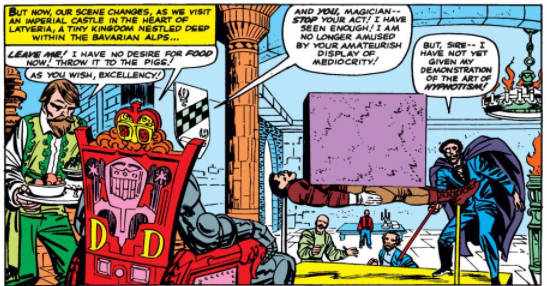 In later years, of course, Latveria would get Netflix and put such artisans out of work. This is the first time that Latveria has appeared in the main Fantastic Four series, having only appeared once before in
In later years, of course, Latveria would get Netflix and put such artisans out of work. This is the first time that Latveria has appeared in the main Fantastic Four series, having only appeared once before in 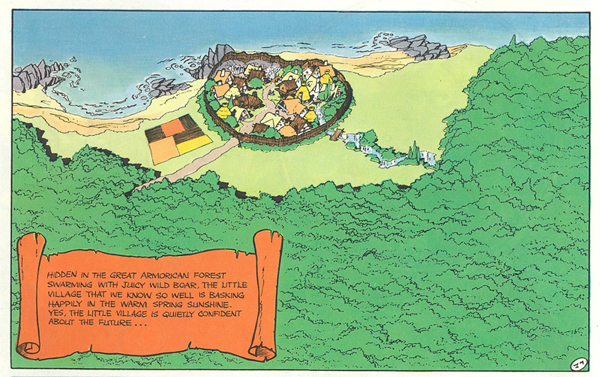 The hypnotist tries to impress his employer by using his mesmeric power on Doom, which I would have thought was a risky strategy. Victor does not seem the sort to laugh at a video of himself pretending to be a chicken. However, this has the unexpected result of removing the hypnotic suggestion implanted in his brain last time we saw him, and he realises that he never defeated Reed Richards at all!
The hypnotist tries to impress his employer by using his mesmeric power on Doom, which I would have thought was a risky strategy. Victor does not seem the sort to laugh at a video of himself pretending to be a chicken. However, this has the unexpected result of removing the hypnotic suggestion implanted in his brain last time we saw him, and he realises that he never defeated Reed Richards at all!
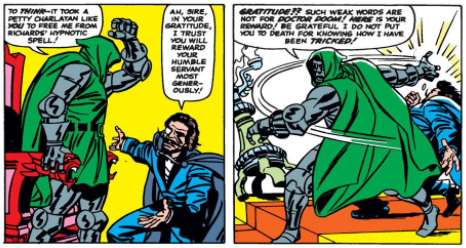 Doom is, understandably, livid, and the fact that a "petty charlatan" revealed the truth to him doesn't go down well either. Doom always claims to be working for the good of the Latverians, but he's never worried about taking his frustrations out on the bearers of bad news, and here he slaps the hypnotist in the face before jumping into a gyroscopic aircraft and heading to New York to take his revenge.
Doom is, understandably, livid, and the fact that a "petty charlatan" revealed the truth to him doesn't go down well either. Doom always claims to be working for the good of the Latverians, but he's never worried about taking his frustrations out on the bearers of bad news, and here he slaps the hypnotist in the face before jumping into a gyroscopic aircraft and heading to New York to take his revenge.
Once he arrives he manages to take over the Baxter Building while The Fantastic Four are away, hiding out in a warehouse trying to get their artificual superpowers to work. Luckily for them their lawyer, Matt Murdock, is visiting, so when Doctor Doom finds out where they are and starts shooting lazers Murdock is able to slip into his other identity of Daredevil to help them out. He's has been their lawyer ever since he stopped Electro from taking over the Baxter Building - a fact I know for sure because Matt Murdock thinks it and then a citation is provided by one of the handy footnotes that litter this story.
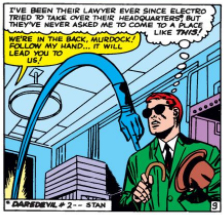 I've noticed these appearing more and more as we move forward with these stories, as Lee and Kirby start to revel in the complexity of the universe they're creating by pointing out to readers how clever they're being. It's an example of a fictional universe being used to enrich the storytelling, rather than control it. If the Fantastic Four need a lawyer, why not make it a character who already exists, and has his own backstory? As we'll see in a few blogs' time, this will have implications both for the Fantastic Four series and for Daredevil's own titles, allowing the character of Doom to develope relationships that will cause him to begin to travel much more widely around the Marvel Universe.
I've noticed these appearing more and more as we move forward with these stories, as Lee and Kirby start to revel in the complexity of the universe they're creating by pointing out to readers how clever they're being. It's an example of a fictional universe being used to enrich the storytelling, rather than control it. If the Fantastic Four need a lawyer, why not make it a character who already exists, and has his own backstory? As we'll see in a few blogs' time, this will have implications both for the Fantastic Four series and for Daredevil's own titles, allowing the character of Doom to develope relationships that will cause him to begin to travel much more widely around the Marvel Universe.
Doctor Doom proceeds to use several of Reed Richards' inventions against him. The four are helpless to fight back, so Daredevil has to protect them by leaping about, distracting Doom, and shoving the FF out of the way of incoming Fantasticars. The Fantastic Four appear to be fascinated by Daredevil's abilities, constantly going on about how agile he is and how he seems to have extra senses, which is exactly what he does have. They are superheroes themselves, so it seems a bit dim not to consider the idea that he might have superpowers too.
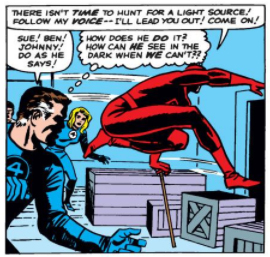 Mind you, they're not the only ones. Doom is utterly perplexed by the way the FF don't fight back, and can't work out what's going on despite the fact that he can clearly see Ben Grimm, who he went to college with, running around with them instead of the Thing. Eventually he works it out, and decides to uses Reed's television monitoring screens to wipe them out.
Mind you, they're not the only ones. Doom is utterly perplexed by the way the FF don't fight back, and can't work out what's going on despite the fact that he can clearly see Ben Grimm, who he went to college with, running around with them instead of the Thing. Eventually he works it out, and decides to uses Reed's television monitoring screens to wipe them out.
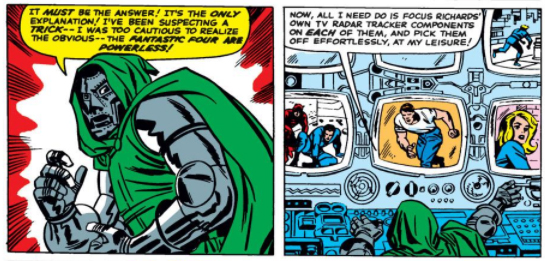 In earlier issues I'd noted how often TV screens are used as part of the plot. This seems to have eased off now, but it's still nice to see Doctor Doom pre-empting Ozymandias in Watchmen by a few years. This seems like a good plan, but he quickly decides that it would be too easy, and that he'd rather spread the fun out a bit more. This is another constant in Doom's character - the need to relish his victory, rather than actually have a victory. You'd think he'd have learnt how this always goes by now, but no, he decides to carry on harrying them with another of Reed's devices.
In earlier issues I'd noted how often TV screens are used as part of the plot. This seems to have eased off now, but it's still nice to see Doctor Doom pre-empting Ozymandias in Watchmen by a few years. This seems like a good plan, but he quickly decides that it would be too easy, and that he'd rather spread the fun out a bit more. This is another constant in Doom's character - the need to relish his victory, rather than actually have a victory. You'd think he'd have learnt how this always goes by now, but no, he decides to carry on harrying them with another of Reed's devices.
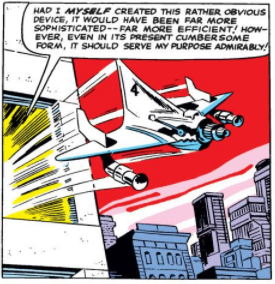 I love the fact that he critices the design of the Force Beam Projectile here - he'd have made a much better one. He keeps saying that he is Reed Richards' "equal" here, but clearly he thinks he's more than that. This obsession with Reed, rather than any of the rest of the Fantastic Four, is now a core part of Doom's personality, and it's something that will never really change.
I love the fact that he critices the design of the Force Beam Projectile here - he'd have made a much better one. He keeps saying that he is Reed Richards' "equal" here, but clearly he thinks he's more than that. This obsession with Reed, rather than any of the rest of the Fantastic Four, is now a core part of Doom's personality, and it's something that will never really change.
The story ends with the Fantastic Four splitting up, deciding to try and get into the Baxter Building from different angles while Daredevil distracts him. Jack Kirby draws this as a quick succesion of character shots, showing Daredevil and each of the four at the same moment, preparing to make their move.
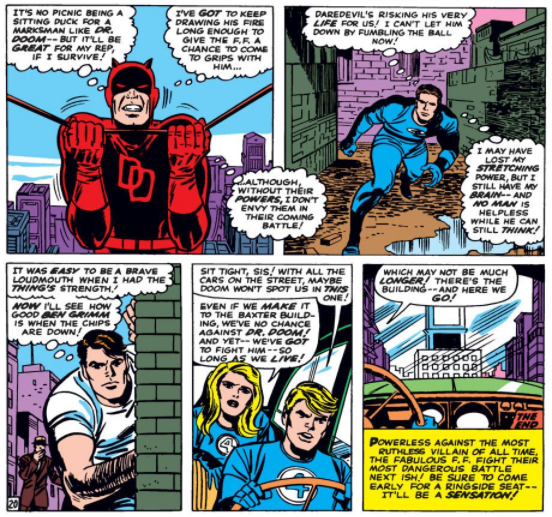 It's a supremely exciting way to ramp up the tension, to such an extent that the first time I read this issue I let out a yelp of frustration because the story had ended. Some of the earlier issues covered in this blog did, I must admit, feel a bit cumbersome and old fashioned, but this one was a joy to read. When's the next one?!?
It's a supremely exciting way to ramp up the tension, to such an extent that the first time I read this issue I let out a yelp of frustration because the story had ended. Some of the earlier issues covered in this blog did, I must admit, feel a bit cumbersome and old fashioned, but this one was a joy to read. When's the next one?!?
(in just two day's time, that's when!)
posted 21/3/2018 by MJ Hibbett
(click here for permanent link)
(0) comments
The Final Victory Of Doctor Doom
Fantastic Four Annual #2 was truly a Doctor Doom bumper edition. After telling The Fantastic Origin of Doctor Doom it featured a gallery of the Fantastic Four's greatest villains, a reprint of Doom's first appearance, pin-ups of the Fantastic Four and some of their supporting cast, and then another new story, "The Final Victory Of Doctor Doom" which we'll be talking about here. If Doom's early popularity was ever in doubt, his domination of this second annual should prove it!
This particular story kicks off with several pages of the usual Fantastic Four hijinks, as the Thing crashes the Fantasticar into an old jalopy and then gets offered a thousand dollars to smash up another car, so that the "crackpot" who pays for it can sell the results off as "an original 'clobber creation' by the famous Thing!".
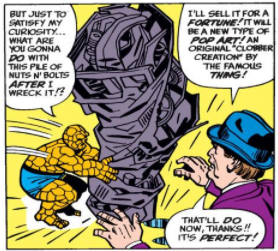 The action then switches to Outer Space, where we find out what happened to Doctor Doom after he fell into it a few months ago. This isn't the first time he's been lost in the infinity of space and, just like last time it happened, he gets picked up by a passing spaceship just in the nick of time.
The action then switches to Outer Space, where we find out what happened to Doctor Doom after he fell into it a few months ago. This isn't the first time he's been lost in the infinity of space and, just like last time it happened, he gets picked up by a passing spaceship just in the nick of time.
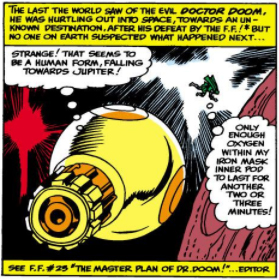 There are many conclusions one could draw from this, but I think that the main one is that Doctor Doom is a right jammy sod, and that if ever you need to go hitch-hiking he would be the perfect partner.
There are many conclusions one could draw from this, but I think that the main one is that Doctor Doom is a right jammy sod, and that if ever you need to go hitch-hiking he would be the perfect partner.
The spaceship belongs to Rama-Tut, who we met not long ago. Once again Lee and Kirby are reinforcing the continuity of their fictional universe, building on past stories to create something more complex and, in this case, more confusing too. Doom tells his saviour the story of how he got here, and we get our second re-telling of the events of Fantastic Four #21. As with the version show in Strange Tales #122, a lot of care has gone into matching the recap to the original version, with Doom's stance as he falls into space being especially carefully redrawn.
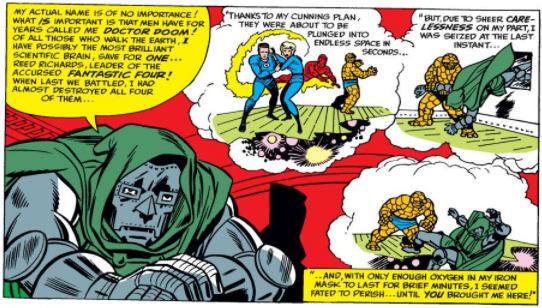 Rama Tut is amazed to discover that he's speaking to his ancestor, and decides that this is far too improbable to just be a coincidence (I'm with the Pharoah on this one), so must be part of a Grand Design. This leads the pair of supervillains to decide that there's a good chance that they could be one and the same person.
Rama Tut is amazed to discover that he's speaking to his ancestor, and decides that this is far too improbable to just be a coincidence (I'm with the Pharoah on this one), so must be part of a Grand Design. This leads the pair of supervillains to decide that there's a good chance that they could be one and the same person.
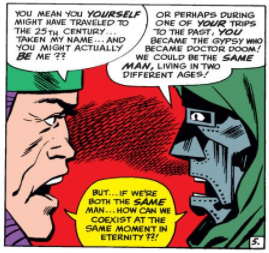 This makes absolutely no sense whatsoever. Surely one of them must be the earlier version, in which case he would remember this meeting having happened before? They also agree that they can't fight the Fantastic Four together, because if they "are one and the same man, and if either is slain, then the other, too, will perish! For you cannot live in the future if you are slain in the past! And I cannot live in the present if my other self dies at the same moment in eternity."
This makes absolutely no sense whatsoever. Surely one of them must be the earlier version, in which case he would remember this meeting having happened before? They also agree that they can't fight the Fantastic Four together, because if they "are one and the same man, and if either is slain, then the other, too, will perish! For you cannot live in the future if you are slain in the past! And I cannot live in the present if my other self dies at the same moment in eternity."
No, Victor, I'm pretty sure it's entirely fine for you to keep living when your future self dies. In a very real sense, that's sort of what we're all doing anyway.
Still, they decide to send Doctor Doom back to Earth to take his revenge, and he parachutes down to New York Harbour before stomping across town to the Latverian Embassy, through a crowd who, he thinks, must be jolly honoured to see him.
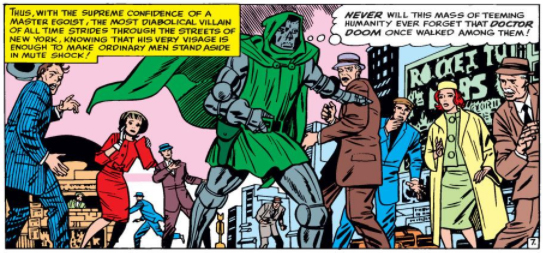 The layout of this panel, and the horrified looks on the faces of the New Yorkers he passes, provides a rather neat counterpoint to the similar scene at the end of Doom's origin story, when he strode past a crowd of his adoring subjects.
The layout of this panel, and the horrified looks on the faces of the New Yorkers he passes, provides a rather neat counterpoint to the similar scene at the end of Doom's origin story, when he strode past a crowd of his adoring subjects.
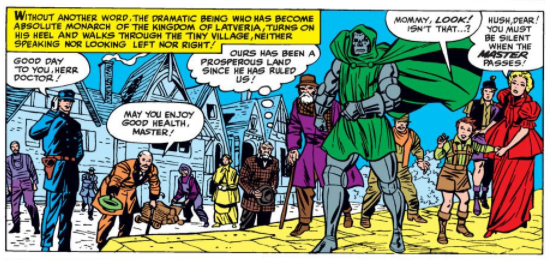 Over at the embassy the Latverian ambassador is denying ludicrous rumours that the Prime Minister is just a puppet, and that there's a secret "real" ruler behind the scenes. He scoffs at such obvious Fake News. "What were you expecting me to admit??" he says. "The presence of some mysterious tyrant who chooses to remain hidden from the world?? This is not a storybook kingdom gentlemen!" He then spots exactly that person in the shape of Doctor Doom entering a sideroom, and brings the meeting to a hasty close.
Over at the embassy the Latverian ambassador is denying ludicrous rumours that the Prime Minister is just a puppet, and that there's a secret "real" ruler behind the scenes. He scoffs at such obvious Fake News. "What were you expecting me to admit??" he says. "The presence of some mysterious tyrant who chooses to remain hidden from the world?? This is not a storybook kingdom gentlemen!" He then spots exactly that person in the shape of Doctor Doom entering a sideroom, and brings the meeting to a hasty close.
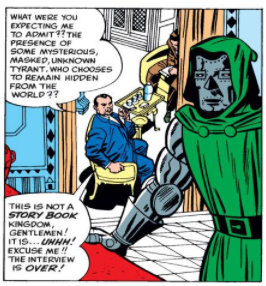 As well as being a great bit of fun, with Lee and Kirby openly mocking the cliches of their own story, it also follows on from the new reality set up in this issue's first story, with Doom as the ruler of distinctly storybook East European kingdom. Latveria was never mentioned before now, but already it feels a natural part of Doom's backstory and thus character. The only oddity about it is that Doom is meant to be the secret ruler, and yet hundreds of New Yorkers have just seen him march across town and, presumably, into the Embassy, like Nigel Farage popping round to see Julian Assange. Surely somebody must have put two and two together?
As well as being a great bit of fun, with Lee and Kirby openly mocking the cliches of their own story, it also follows on from the new reality set up in this issue's first story, with Doom as the ruler of distinctly storybook East European kingdom. Latveria was never mentioned before now, but already it feels a natural part of Doom's backstory and thus character. The only oddity about it is that Doom is meant to be the secret ruler, and yet hundreds of New Yorkers have just seen him march across town and, presumably, into the Embassy, like Nigel Farage popping round to see Julian Assange. Surely somebody must have put two and two together?
Doom immediately sets to work with his latest cunning plan by getting the ambassador to invite the Fantastic Four to a fancy reception, where they're due to be awarded a Scientific Fellowship. This leads to a gorgeous splash panel showing them looking a little bit uncomfortable being toasted by the gathered delegates.
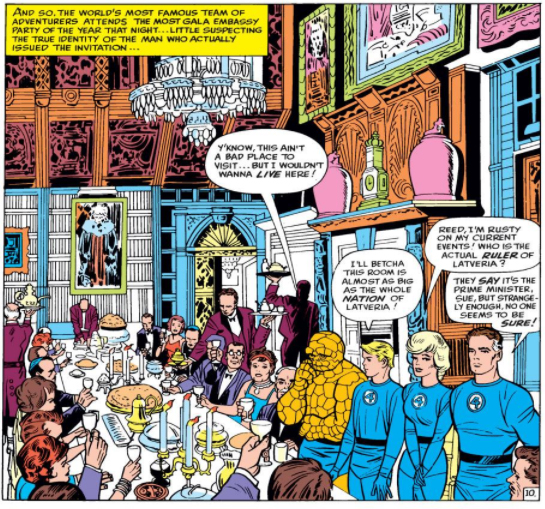 Doom's plan is to drug the Fantastic Four with a special "berry drink" that makes them believe whatever he desires them to believe - in this case making Johnny think that Ben has thumped him, and making Sue imagine she sees Reed being unfaithful. Johnny and Ben start a fight which, let's be honest, doesn't really require the assistance of mind altering drugs as it happens pretty much every month anyway, and Sue and Reed have a big argument, which... well, see above.
Doom's plan is to drug the Fantastic Four with a special "berry drink" that makes them believe whatever he desires them to believe - in this case making Johnny think that Ben has thumped him, and making Sue imagine she sees Reed being unfaithful. Johnny and Ben start a fight which, let's be honest, doesn't really require the assistance of mind altering drugs as it happens pretty much every month anyway, and Sue and Reed have a big argument, which... well, see above.
It's all part of Doom's plan anyway, and he takes a moment to savour the imminence of his final victory. Unfortunately his triumph soon takes a turn for the maudlin as he has a moment of self-awareness, wondering if beating his rivals will ever make up for what he's lost along the way.
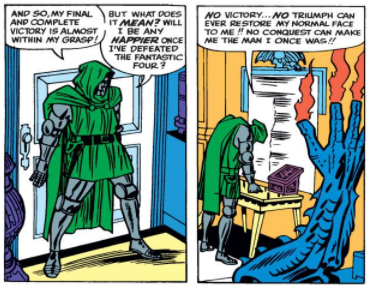 He looks at himself in the mirror and becomes so upset that he starts blasting the reflection with his laser gun. This disrupts Sue and Reed's fight, leading them to discover that Doom was behind it all along.
He looks at himself in the mirror and becomes so upset that he starts blasting the reflection with his laser gun. This disrupts Sue and Reed's fight, leading them to discover that Doom was behind it all along.
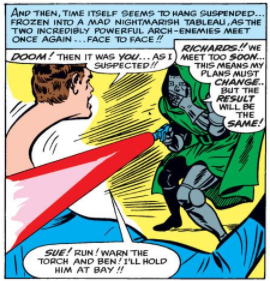 I've double checked, and this is definitely the first time that Reed has voiced his so-called suspicion that Doom was behind it all. He compounds this dickery with a heavy slice of misogyny, telling Sue she's "Not a fool, merely a female", before going to round up the rest of the team so they can take on Doom together.
I've double checked, and this is definitely the first time that Reed has voiced his so-called suspicion that Doom was behind it all. He compounds this dickery with a heavy slice of misogyny, telling Sue she's "Not a fool, merely a female", before going to round up the rest of the team so they can take on Doom together.
They return to their headquarters to find Doom waiting for them, and a battle ensues which sees them fighting each other to a stalemate. Reed offers Doom the chance to fight him man to man in a battle of wits, which they agree to over a drink.
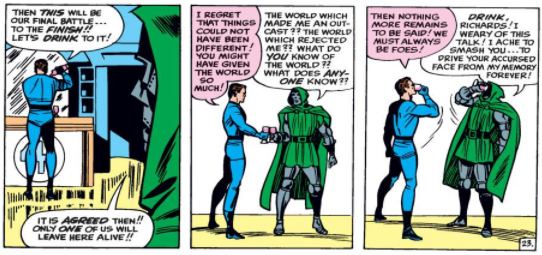 They strap themselves into "The Encephalo Gun" and commence a mighty battle of intelligence which ends, astonishingly, with Doom triumphant and Reed Richards cast into limbo forever!
They strap themselves into "The Encephalo Gun" and commence a mighty battle of intelligence which ends, astonishingly, with Doom triumphant and Reed Richards cast into limbo forever!
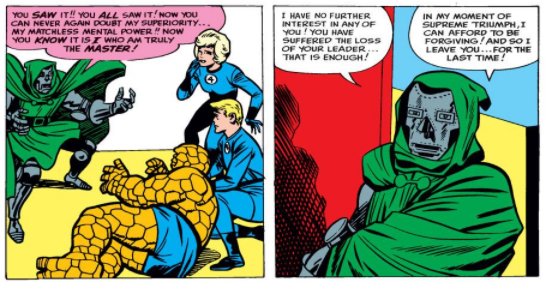 I guess we shouldn't be too surprised - after all, the story is called "The Final Victory Of Doctor Doom", but when he leaves we see that Reed is still there - the drink he gave Doom was exactly the same "berry drink" that had been use to drug the rest of the team earlier. Doom's victory was entirely illusory! Ha!
I guess we shouldn't be too surprised - after all, the story is called "The Final Victory Of Doctor Doom", but when he leaves we see that Reed is still there - the drink he gave Doom was exactly the same "berry drink" that had been use to drug the rest of the team earlier. Doom's victory was entirely illusory! Ha!
Ben wants to go and grab Doom before he gets away, but Reed points out that, as head of a foreign nation, he has diplomatic immunity from detention. I'm not sure if this is exactly how diplomatic immunity works, but it's another extra element of Doom's character that gets added here, and another bit of Marvel "realism" in that he now has a superpower that dictators have in our world too.
The final panel sees the Fantastic Four wandering what could have made Doom turn out as he has. "Perhaps, if we could ever learn more of is past..." muses Reed, apparently forgetting that they went to college together and he was heavily involved in a large part of his past. Maybe he should pick up a copy of this very comic and refresh his memory?
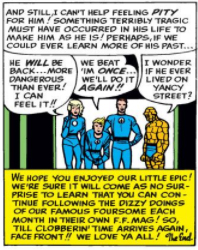 And thus concludes a story which addes tonnes of new detail, and new complexities, to Doctor Doom's character. Whereas the previous story told us about his past, this one delves deeper into the implications of his current status. It doesn't all necessarily make sense, but it will have huge repercussions for Doctor Doom in the future, setting the scene for an already popular supporting character to become one of the most interesting too.
And thus concludes a story which addes tonnes of new detail, and new complexities, to Doctor Doom's character. Whereas the previous story told us about his past, this one delves deeper into the implications of his current status. It doesn't all necessarily make sense, but it will have huge repercussions for Doctor Doom in the future, setting the scene for an already popular supporting character to become one of the most interesting too.
posted 9/3/2018 by MJ Hibbett
(click here for permanent link)
(0) comments
The Fantastic Origin Of Doctor Doom
When Doctor Doom's origin story was finally told, here in Fantastic Four Annual #2, it had been two years and at least seven separate stories since his first appearance, way back in Fantastic Four #5. In the introduction to Bring On The Bad Guys, a reprint collection of supervillain origin stories, Stan Lee claimed this was deliberate, saying that "... it wasn't until 1964 that we really had time to do the kind of origin tale I felt Doc Doom deserved ... one that would make the reader really understand what motivated him, what had turned him into a villain, what made him the tragic, tortured tyrant he was."
I don't know whether that's an accurate description of why it took so long - there was, after all, a very abbreviated origin back in Fantastic Four #5 - but, to take my sober, analytical, academical hat off just for a moment, I have to say that it was totally worth the wait for this "full" version of the origin story as it is a CRACKER! Doctor Doom has, until now, been an interesting antagonist with a brilliant design and hints at greater depth, but suddenly, in this issue, we're introduced to a vast wealth of background detail. In places it all feels oddly like a superhero origin, very similar to Batman's origin, not least in the fact that both characters are orphaned when they are very young and swear vengeance upon their parents' killers. Doom's enemy is not a mugger, however, but the state itself. Where Batman sets out to fight the injustices of crime, Doctor Doom fights the injustices of government.
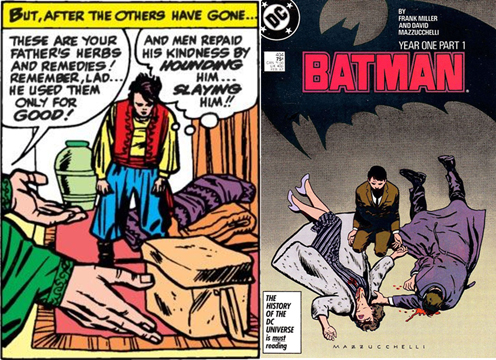 This story begins in the present day, with Doom's servant Boris collecting his master for a visit to a mysterious grave. They're in Latveria, a small East European country "nestling in the heart of the Bavarian alps" which also happens to be Doom's kingdom. This is the first time we've heard any of this, and the way it's all dropped on the reader in one go without apology or explanation is a real jolt. The last time we saw Doom he was lost in space (again), and although that will all be explained later, in the second story in this comic, it's not mentioned here at all.
This story begins in the present day, with Doom's servant Boris collecting his master for a visit to a mysterious grave. They're in Latveria, a small East European country "nestling in the heart of the Bavarian alps" which also happens to be Doom's kingdom. This is the first time we've heard any of this, and the way it's all dropped on the reader in one go without apology or explanation is a real jolt. The last time we saw Doom he was lost in space (again), and although that will all be explained later, in the second story in this comic, it's not mentioned here at all.
Instead of a recap we're thrown into a flashback of Doom's youth in Latveria. It's a very confusing place, with Jack Kirby's illustrations showing an almost medieval world of peasant cottages and gypsy caravans living side by side with high tech tanks and force fields.
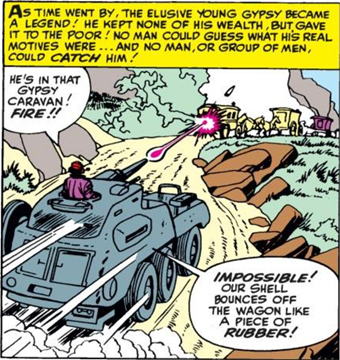 One of the main factors in the success of early Marvel was Lee and Kirby's ongoing mission to combine reality with fantasy, most notably in the way they placed fantastical superhero stories in a recognisably realistic version of Manhattan. They appear to be attempting something similar here, transposing the action to a version of Eastern Europe, although the people of Latveria look more like characters from Hollywood movies set in "ye olde Europe", wearing lederhosen and dirndl, than contemporary citizens of this part of the world in "our" universe.
One of the main factors in the success of early Marvel was Lee and Kirby's ongoing mission to combine reality with fantasy, most notably in the way they placed fantastical superhero stories in a recognisably realistic version of Manhattan. They appear to be attempting something similar here, transposing the action to a version of Eastern Europe, although the people of Latveria look more like characters from Hollywood movies set in "ye olde Europe", wearing lederhosen and dirndl, than contemporary citizens of this part of the world in "our" universe.
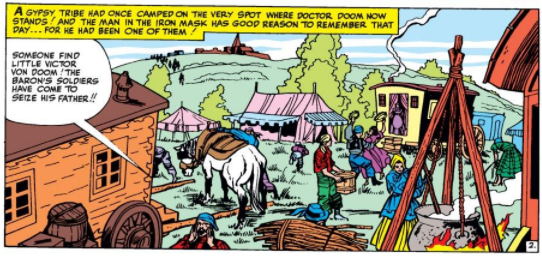 We might be able to explain this confused idea of Eastern Europe by considering Lee and Kirby's backgrounds. Both men spent a great deal of their youths in cinemas, absorbing Hollywood versions of Europe, and had first generation Jewish immigrant parents who had fled to America to escape persecution - The Kurzbergs (Kirby's real family name) coming from Austria and the Leibers from Romania. Kirby talked about this in his autobiographical (and brilliant) strip Street Code, describing his youth as "A time when Europe was still visible to your parents".
We might be able to explain this confused idea of Eastern Europe by considering Lee and Kirby's backgrounds. Both men spent a great deal of their youths in cinemas, absorbing Hollywood versions of Europe, and had first generation Jewish immigrant parents who had fled to America to escape persecution - The Kurzbergs (Kirby's real family name) coming from Austria and the Leibers from Romania. Kirby talked about this in his autobiographical (and brilliant) strip Street Code, describing his youth as "A time when Europe was still visible to your parents".
We can use deduction and high powered maths to work out that this flashback must be set in the 1930 - Doom is roughly the same age as Reed Richards, who fought in World War Two (at least, he did in this early version of the Marvel Universe) before going to college- when gypsies like Doom's family were routinely persecuted in Europe. Here Doom's father, a doctor, is kidnapped by Latveria's secret police to attend to the wife of their hereditary ruler, the Baron (Why a country continually referred to as a kingdom is ruled by a Baron is not explained). When the Baron's wife dies the von Dooms have to flee, and Victor's father dies of exposure while trying to lead his son to safety. This part of the origin may have its roots in Kurzberg family legend - Kirby claimed that "my father had insulted a member of the German aristocracy. My father knew he'd be killed, so he decided to emigrate."
When he is returned to the gypsy camp Victor sorts through his father's effects and discovers that his mother, who died giving birth to him, was a witch, and decides to use her potions and devices to take revenge on Latveria's rich and corrupt upper classes.
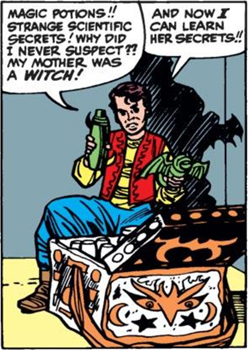 After a series of ingenious guerrilla attacks Doom comes to the attention of the Dean Of Science at State University, who travels to Latveria to invite him to attend college in the USA. This is cultural imperialsim, and it's the point where Doom's origin changes to that of a supervillain. When the Dean transports him from his pro-social roots to a new, unfamiliar environment, he finds it increasingly difficult to fit in with the all-American student body (including a gratingly eager Reed Richards) and isolates himself, conducting terrible experiments which ultimately, literally, blow up in his face.
After a series of ingenious guerrilla attacks Doom comes to the attention of the Dean Of Science at State University, who travels to Latveria to invite him to attend college in the USA. This is cultural imperialsim, and it's the point where Doom's origin changes to that of a supervillain. When the Dean transports him from his pro-social roots to a new, unfamiliar environment, he finds it increasingly difficult to fit in with the all-American student body (including a gratingly eager Reed Richards) and isolates himself, conducting terrible experiments which ultimately, literally, blow up in his face.
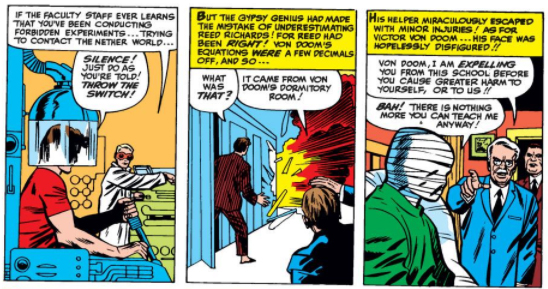 As with previous recaps, it's worth noting how closely this section reflects the original origin we saw back in Fantastic Four #5.
As with previous recaps, it's worth noting how closely this section reflects the original origin we saw back in Fantastic Four #5.
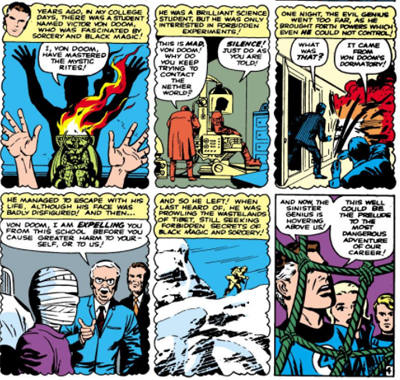 As explained back then, when Doom is expelled from college he sets off on a journey into the himalayas to find a mountain community of monks who can help him continue his study of the dark arts. A quest for special powers in the exotic East is a common story trope in Western fiction,especially in superhero stories, and features in the origin stories of Doc Savage, Doctor Strange, Deadman and indeed in later version of Batman's origin. Usually the Western student learns from the Eastern mystics, but here Doom makes himself leader of the monks, ordering them to build him a high-tech suit of armour and face-mask which, when worn, transforms him into his true self - Doctor Doom!
As explained back then, when Doom is expelled from college he sets off on a journey into the himalayas to find a mountain community of monks who can help him continue his study of the dark arts. A quest for special powers in the exotic East is a common story trope in Western fiction,especially in superhero stories, and features in the origin stories of Doc Savage, Doctor Strange, Deadman and indeed in later version of Batman's origin. Usually the Western student learns from the Eastern mystics, but here Doom makes himself leader of the monks, ordering them to build him a high-tech suit of armour and face-mask which, when worn, transforms him into his true self - Doctor Doom!
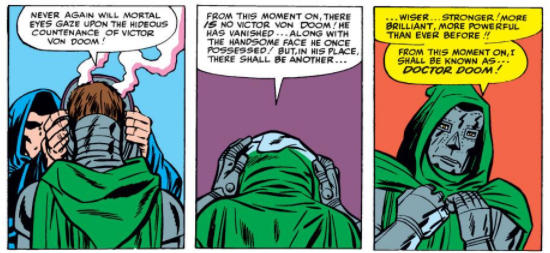 Stan Lee has said several times that he never thought of Doom as a villain, but that doesn't mean that this is a superhero story either. Superhero stories of this era, including origins, tended to follow what Robert Jewett and John Shelton Lawrence called "the American Monomyth", where a mysterious stranger arrives in town, sees oppression, intervenes to stop it, and then fades away. Doom's origin has much more in common with Joseph Campbell's "The Hero's Journey", a universal myth where a young man is called away to adventure, endures trials and eventually returns home changed (I'm putting publishers out of business here aren't I?). This is exactly what happens to Doom, with him returning home and conquering Latveria for himself, where the delighted citizens happily salute him as 'The Master' as the story ends.
Stan Lee has said several times that he never thought of Doom as a villain, but that doesn't mean that this is a superhero story either. Superhero stories of this era, including origins, tended to follow what Robert Jewett and John Shelton Lawrence called "the American Monomyth", where a mysterious stranger arrives in town, sees oppression, intervenes to stop it, and then fades away. Doom's origin has much more in common with Joseph Campbell's "The Hero's Journey", a universal myth where a young man is called away to adventure, endures trials and eventually returns home changed (I'm putting publishers out of business here aren't I?). This is exactly what happens to Doom, with him returning home and conquering Latveria for himself, where the delighted citizens happily salute him as 'The Master' as the story ends.
 The full story of how he overthrew the previous ruler would not be told until "The Books Of Doom" mini-series many years later, but it's clear already that, although he's not a superhero, hes not a hated dictator either. He's more like a beloved national leader in the mould of General Tito, who takes power in order to protect his people from those who would do them harm - someone Americans would be wary of, but also respect.
The full story of how he overthrew the previous ruler would not be told until "The Books Of Doom" mini-series many years later, but it's clear already that, although he's not a superhero, hes not a hated dictator either. He's more like a beloved national leader in the mould of General Tito, who takes power in order to protect his people from those who would do them harm - someone Americans would be wary of, but also respect.
By the end of this story Doctor Doom has finally become the character that he would, for the most part, remain for the next five decades. There would be changes in the way he was interpreted over the years, as we'll see as this Doom progresses, but he is now, at last, recognisably Doom!
All that is to come, but for now there's a whole other Doom-focused story in this double sized issue, where we find out what actually did happen to Doom, out in space. See you next time!
posted 7/3/2018 by MJ Hibbett
(click here for permanent link)
(2) comments
3 Against The Torch!
I'm a big fan of the cheeky daftness of this era of Marvel, so I love the fact that the cover says "Doctor Doom does not appear in this story! We just felt like drawing his face!" It reminds me of the humour of Leo Baxendale's Willy The Kid and other strips, mucking about with the form and joining in with the readers mocking the conventions of the format.
I also like the fact that it's not even true, as Doom appears throughout the start of the issue as it recaps the events of Fantastic Four #23... even though the issue itself says it was #22.
 As with the recap in Amazing Spider-Man #5, a lot of care seems to have gone into making sure that the recap matches the original story (a lot more care than was taken in making sure they got the issue number right!) with several panels being redrawn - again, reinforcing the Ontological Trust (hem hem) of the fictional universe.
As with the recap in Amazing Spider-Man #5, a lot of care seems to have gone into making sure that the recap matches the original story (a lot more care than was taken in making sure they got the issue number right!) with several panels being redrawn - again, reinforcing the Ontological Trust (hem hem) of the fictional universe.
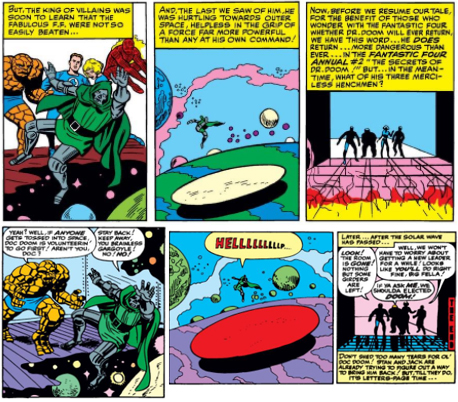 We also discover that Doom's three crooks were returned to our dimenson as soon as he fell into space... and that his knack for inspiring loyalty is undiminished, as the three of them decide to try and bring down the Fantastic Four themselves in order to please their boss.
We also discover that Doom's three crooks were returned to our dimenson as soon as he fell into space... and that his knack for inspiring loyalty is undiminished, as the three of them decide to try and bring down the Fantastic Four themselves in order to please their boss.
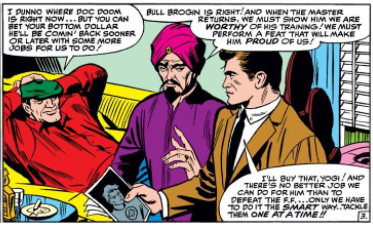 They then basically re-use Doom's old plan, flattering Johnny Storm for his knowledge of cars so they can kidnap him. This interrupts the Torch enjoying one of the recurring themes of this era of Marvel - watching television. Reading through these comics it's surprsing how much television turns up, it's the equivalent of every comic published today mentioning mobile phone apps or something.
They then basically re-use Doom's old plan, flattering Johnny Storm for his knowledge of cars so they can kidnap him. This interrupts the Torch enjoying one of the recurring themes of this era of Marvel - watching television. Reading through these comics it's surprsing how much television turns up, it's the equivalent of every comic published today mentioning mobile phone apps or something.
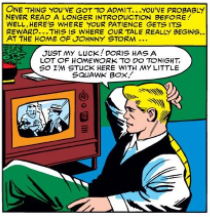 The rest of the issue is Johnny fighting the three crooks, and ends with him getting a telling off from his sister because their house got messed up when he was kidnapped. It looks as if he's in the doghouse but then, in the very last panel, the Torch addresses the reader directly to tell them it all worked out in the end.
The rest of the issue is Johnny fighting the three crooks, and ends with him getting a telling off from his sister because their house got messed up when he was kidnapped. It looks as if he's in the doghouse but then, in the very last panel, the Torch addresses the reader directly to tell them it all worked out in the end.
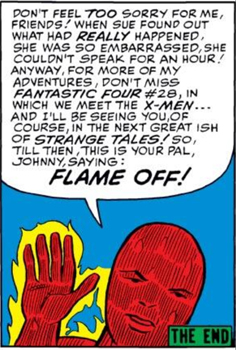 There's been plenty of interaction with the reader via captions, but this is the first time I've seen a character break the fourth wall in this way. Many years later other characters would do this on a regular basis, including future FF member She-Hulk, but this piece of metalepsis (why yes, I have been away on a week long Winter School where I learnt this term, why do you ask?) is completely out of the blue, not to mention slightly unnecessary. It's not like readers would be traumatised about Johnny getting told off in this way, so I'm not sure why Stan Lee felt the need to include his speech, but I guess it's a suitably wonky ending for a story that's been wonky from the start.
There's been plenty of interaction with the reader via captions, but this is the first time I've seen a character break the fourth wall in this way. Many years later other characters would do this on a regular basis, including future FF member She-Hulk, but this piece of metalepsis (why yes, I have been away on a week long Winter School where I learnt this term, why do you ask?) is completely out of the blue, not to mention slightly unnecessary. It's not like readers would be traumatised about Johnny getting told off in this way, so I'm not sure why Stan Lee felt the need to include his speech, but I guess it's a suitably wonky ending for a story that's been wonky from the start.
posted 5/3/2018 by MJ Hibbett
(click here for permanent link)
(0) comments